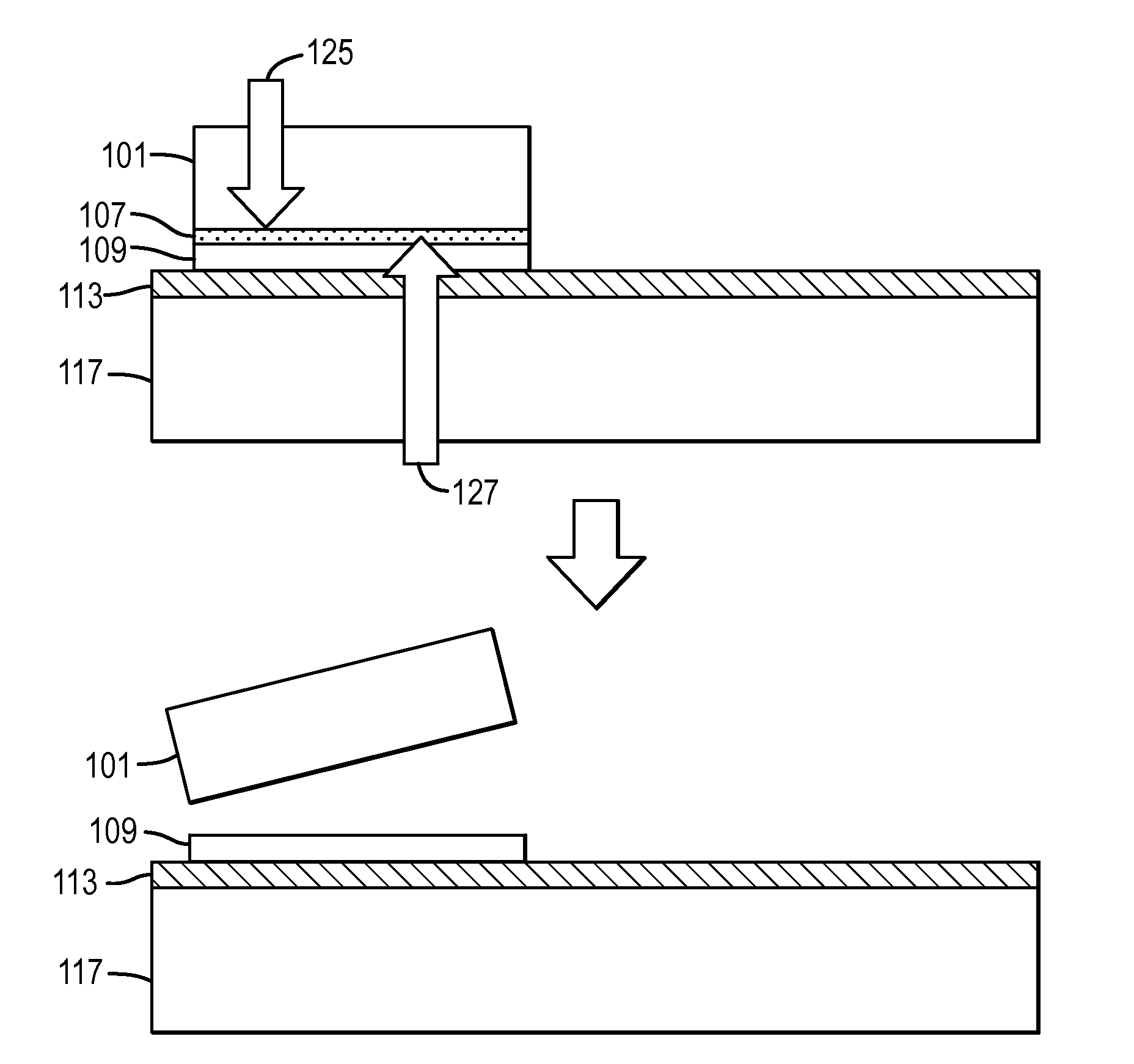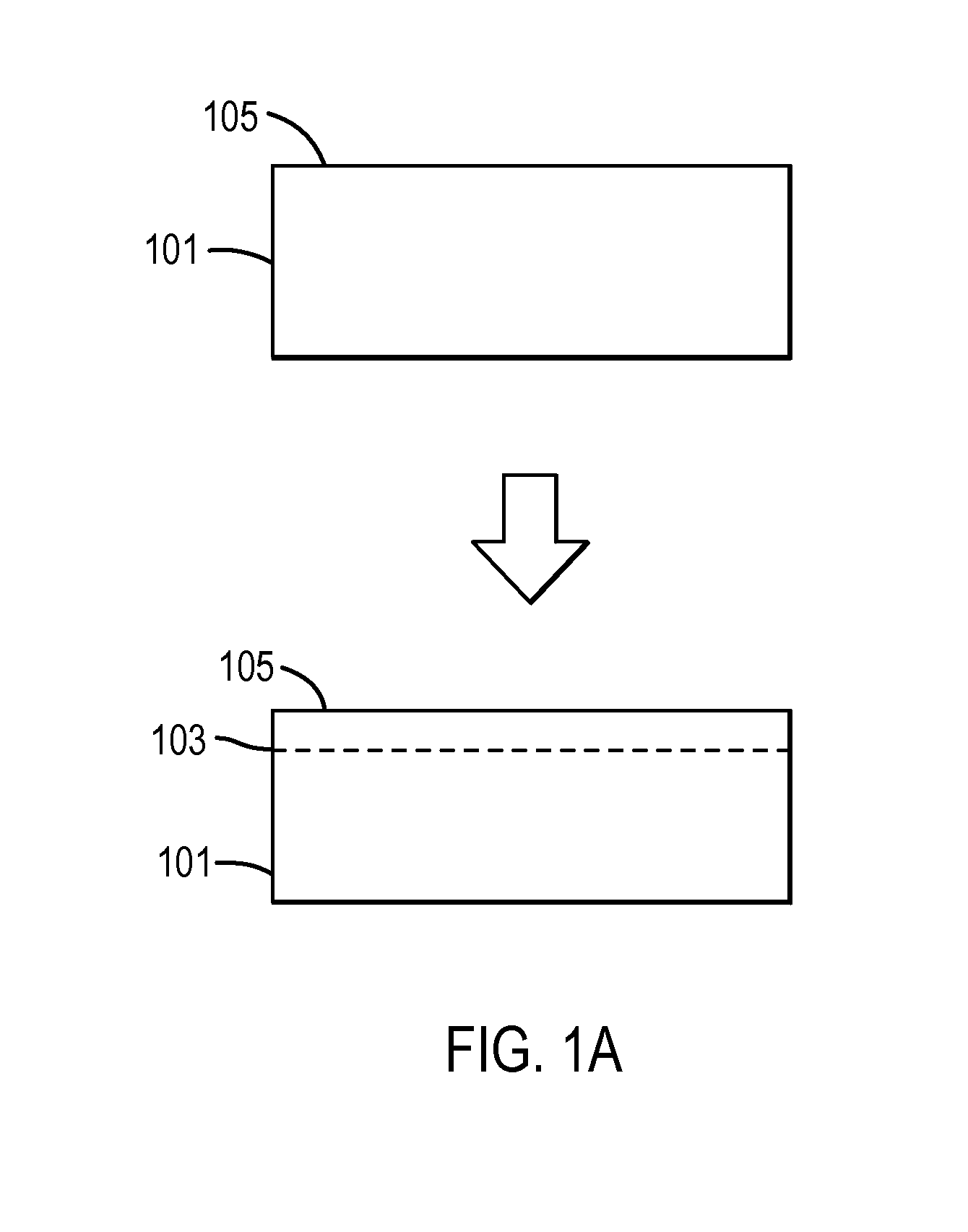Large area nitride crystal and method for making it
a nitride crystal, large-area technology, applied in the direction of polycrystalline material growth, crystal growth process, after-treatment details, etc., can solve the problems of high density, difficult to produce dislocation density, and high density of dislocation crystals, and achieve high quality
- Summary
- Abstract
- Description
- Claims
- Application Information
AI Technical Summary
Benefits of technology
Problems solved by technology
Method used
Image
Examples
example 1
[0091]A template was prepared using four HVPE-grown bulk GaN crystals wafer-bonded to a handle substrate, also comprising HVPE-grown bulk GaN. The nitride crystals exhibited a crystallographic orientation within 1 degree of the (0 0 0 1) +c-plane (Ga face). The adjoining surfaces of the nitride crystals and the handle substrate were each coated with a 200 Angstrom Ti layer followed by a 1.5 micron Au layer and wafer-bonded at a pressure of 5.4 MPa and a temperature of 450° C. under vacuum. The gaps between adjacent bonded nitride crystals were approximately 85 microns. The misorientation angles α, β, and γ between the adjacent bonded nitride crystals were all less than 0.1 degrees. The template was degreased, suspended by a silver wire, and placed in a silver capsule with a baffle. Approximately 37.3 g of polycrystalline GaN, 1.27 g of NH4F mineralizer, and 30.4 g of ammonia were also placed in the capsule and the capsule was hermetically sealed. The capsule was placed in an interna...
example 2
[0092]A template was prepared using two HVPE-grown bulk GaN crystals bonded to a handle substrate, also comprising HVPE-grown bulk GaN. The nitride crystals exhibited a crystallographic orientation within 1 degree of the (0 0 0 1) +c-plane (Ga face). The adjoining surfaces of the handle substrate and the nitride crystals were coated with a 200 Angstrom Ti layer followed by a 1.0 micron Au layer. The nitride crystals further had an array of 300 micron diameter Si dots having a height of 0.6 microns, the dots being located at the vertices of a square grid having a period of 1,000 microns in both the x- and y-directions. The handle substrate was then placed on a heated stage at 475° C. and a pick and place tool was used to precisely position the two nitride crystals on the handle substrate. The adjoining surfaces of the nitride crystals and the handle substrate, while precisely aligned, were placed in contact for approximately 30 seconds and a bond was formed. The misorientation angles...
example 3
[0093]A template was prepared using three HVPE-grown bulk GaN crystals bonded to a handle substrate, also comprising HVPE-grown bulk GaN. The nitride crystals exhibited a crystallographic orientation that was miscut from the {1 0 −1 0} m-plane by approximately 0.25 degree toward [0 0 0 −1]. The adjoining surfaces of the handle substrate and the nitride crystals were coated with a 200 Angstrom Ti layer followed by approximately a 20 micron thick Au layer and 3 micron thick AuSn layer on the handle substrate and the nitride crystals, respectively. The handle substrate was then placed on a heated stage at 330° C. and a pick and place tool was used to precisely position the three nitride crystals on the handle substrate. The adjoining surfaces of the nitride crystals and the handle substrate, while precisely aligned, were placed in contact for approximately 30 seconds and a bond was formed. The template was degreased and placed in a silver capsule with a baffle. Approximately 4,815 g of...
PUM
 Login to View More
Login to View More Abstract
Description
Claims
Application Information
 Login to View More
Login to View More - R&D
- Intellectual Property
- Life Sciences
- Materials
- Tech Scout
- Unparalleled Data Quality
- Higher Quality Content
- 60% Fewer Hallucinations
Browse by: Latest US Patents, China's latest patents, Technical Efficacy Thesaurus, Application Domain, Technology Topic, Popular Technical Reports.
© 2025 PatSnap. All rights reserved.Legal|Privacy policy|Modern Slavery Act Transparency Statement|Sitemap|About US| Contact US: help@patsnap.com



